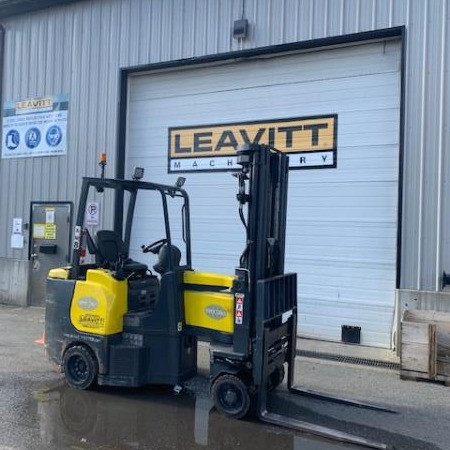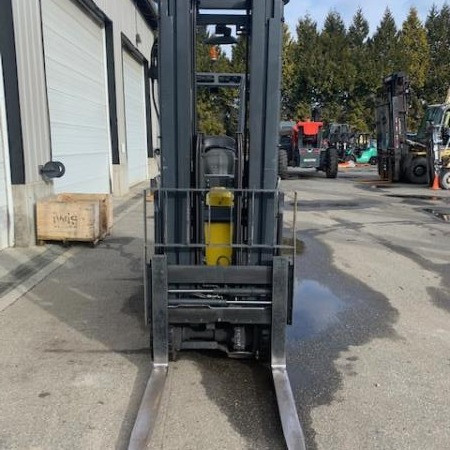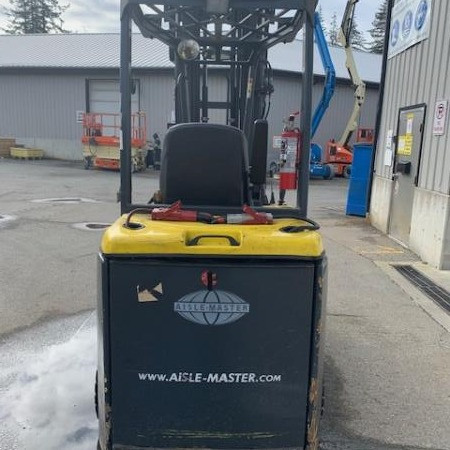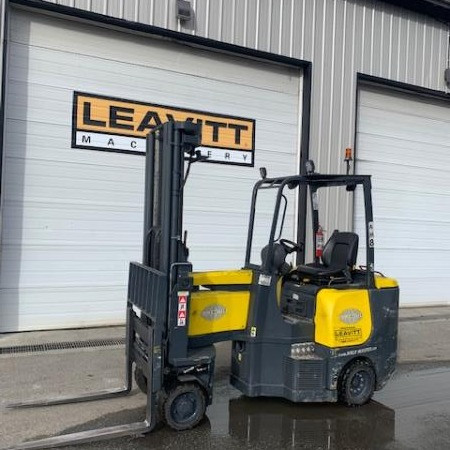Very Narrow Aisle Forklift Hayward
Used Very Narrow Aisle Forklift Hayward - Warehousing needs greatly focus on space-saving techniques and layout to maximize expensive square footage and decrease travel time needed to get goods from the loading docks and from point A to point B. Extremely narrow aisles offer more storage space since there is less space needed for aisle access. Configuring the warehouse is known as warehouse optimization.
Warehouse Optimization
Several benefits can be enjoyed for adding very narrow aisle warehouse optimization such as more storage space for the facility.
Because very narrow forklift trucks were developed to take up less space in maneuvering, it is now possible to decrease warehouse aisle width to less than half the width required by standard forklifts. Certain models of very narrow aisle forklifts can increase the square foot storage capabilities by delivering greater stacking heights. Costs can be drastically decreased with a narrow aisle forklift compared to a standard aisle configuration as less warehouse space is required for the same quantity of stock. Square footage is costly in urban areas and any way to reduce warehousing costs can save a company money. When planned carefully and properly, it is possible to increase warehouse storage area by up to 80 percent by implementing a very narrow aisle width configuration. This warehouse design creates more rack faces and increased product access. Reduced travel time for storing items and gathering products are some of the key benefits to this warehouse layout as more products are found in an accessible location.
Very narrow aisle layouts and narrow aisle layouts are popular for warehouses. Narrow aisles are usually those that use less than 11 feet of aisle width. Very narrow aisles usually use an aisle width of approximately 6.5 feet across. Either of these widths drastically increases storage potential. Standard forklifts can have issues with turning in these aisle widths. These challenges are met by using very narrow forklifts to gain access and complete tasks.
Before choosing a forklift for a particular job, it is vital to know the dimensions of the aisle. It is important to have the correct aisle dimensions before forklift shopping to avoid securing a machine that won’t fit its’ intended location. Taking note of any utilities, columns or posts is necessary before choosing a particular narrow aisle forklift design to maximize warehouse optimization and safety.
Very Narrow Aisle Forklift Trucks
Rechargeable batteries are typical for powering very narrow aisle forklift trucks and most models are electric. These very narrow aisle trucks are more commonly available as stand-up riders, which helps increase productivity and operator comfort. The most commonly used types of very narrow aisle forklift trucks are:
1. Reach trucks
2. Order pickers;
3. End-control riders; and
4. Turret or swing-mast.
Reach Forklift Trucks
Reach trucks were designed as a version of the rider stacker forklift but specially modified for use in narrow aisles. It got its name by its function of reaching its forks forward to get to a load. The moving mast and the moving carriage are two types of reach trucks. The moving carriage functions by lowering and raising the carriage and the operator. While the operator stays at ground level, the moving mast is responsible for raising and lowering the forks. The moving reach truck is typically considered the safest out of the two kinds of reach trucks. Reach trucks utilize a pantograph system that is a jointed framework design enabling the driver to place and reach loads without moving the forklift.
Order Pickers
Order pickers were created to specifically pick orders from difficult-to-access racks. Order pickers are specific for lighter stock items that can be lifted by hand. They lift the operator up to reach the goods by identifying and choosing certain items to create an order.
End-Control Riders
End-control riders are used to pick loads located at floor level and transport the load horizontally, rather than lift or lower loads from various heights.
Turret or Swing-Mast Forklift
Turret or swing-mast very narrow aisle forklift have a pivoting articulating swivel mast. The mast swivels to enable pallets to be positioned on the right or left side of the forklift.
Guided Very Narrow Aisle Trucks
Many very narrow aisle forklift trucks are able to be guided down aisles by wire or rail.
Because the forklift is guided, thereby reducing the possibility of the forklift bumping racks while moving down the aisle, the aisles can be extremely narrow. In rail-guided models, sets of rails are placed into the floor on each side of the aisle. They run the length of the aisle and also curve around the aisles’ edge. Wheel guides on the forklift slide into the floor rails to stop the machine from traveling out of bounds.
Wire-guidance forklift systems install wires on the floor instead of rails and the wires run down the middle of the aisle. The wire-guides function similarly to the rail systems except the forklift has a wire-guide system to prevent the machine from traveling where it is not supposed to.
Work Site Considerations
To use a narrow aisle configuration, there are some key considerations that need to be made. Because these very narrow aisle configurations include very tall racking systems, the condition of the floor and the construction of the racks must be done properly in order to avoid potentially disastrous outcomes. Four specific areas need to be perfectly prepared before a racking system can be implemented including a level floor, plumb racks, any floor cracks need to be repaired and the floor’s load capacity must be accurate. These locations need to be maintained and monitored continuously.
Level Floor
Due to the racking system height, any minor floor slope can gravely impact how plumb the racks are, particularly over time if loads are placed and removed repeatedly on the racks. The height of the racking system means that any minute floor slope can have a negative impact on how straight the racks are, especially over time when loads are continually removed and placed on the racks. Without a level floor foundation, the rack stability could be compromised.
Crack Repair
Cracks in the floor ideally should be fixed once they are noticed to ensure everyone’s safety. The level of the floor can become unstable with cracks when they are only 3/8 inches wide. They will need to be filled properly with material as hard as the rest of the floor.
Floor Load Capacity
Minimum flooring requirements must be met before considering a narrow aisle installation. At a minimum, the floor should consist of 3,000 psi concrete as well as contain evenly distributed rebar approximately 3 to 4 inches below the surface. Extra reinforcements might be needed depending on the load requirements and the configuration.
Plumb Racks
The racking system is essential to the whole process and needs to be installed properly. If installed improperly, there is a great chance of rack failure. All racks need to be plumb and this is one of the most vital aspects of correct installation. Rack shims can help the rack stay plumb to one inch at the height of thirty feet.
Dangerous racking failure can occur if the above steps are not taken. Racking failure can kill or injure employees, damage equipment and result in horrible damage. These measurements are vital to the success of installing a safe and productive narrow aisle configuration.
Very Narrow Aisle Forklift PDF
Stock Number: 209213 GL
Make: AISLEMASTER
Model: 44SE
Year: 2015
| Stock Number |
209213 GL |
| Make |
AISLEMASTER |
| Model |
44SE |
| Year |
2015 |
| Category |
Very Narrow Aisle Forklift |
Stock Number: 207213 GL
Make: AISLEMASTER
Model: 44E
Year: 2013
| Stock Number |
207213 GL |
| Make |
AISLEMASTER |
| Model |
44E |
| Year |
2013 |
| Category |
Very Narrow Aisle Forklift |
Stock Number: 208758 GL
Make: AISLEMASTER
Model: 44SE
Year: 2015
| Stock Number |
208758 GL |
| Make |
AISLEMASTER |
| Model |
44SE |
| Year |
2015 |
| Category |
Very Narrow Aisle Forklift |













